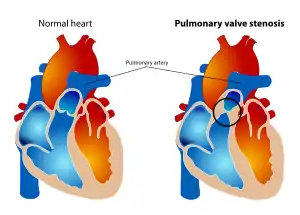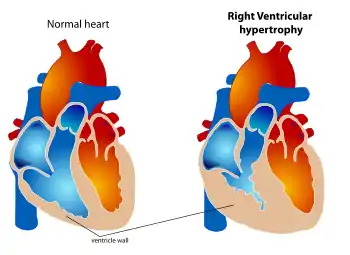Trilogy of Fallot
The Trilogy of Fallot also called Fallot's trilogy is a rare congenital heart disease consisting of the following defects: pulmonary valve stenosis, right ventricular hypertrophy and atrial septal defect.[1] It occurs in 1.2% of all congenital heart defects.[2]
| Trilogy of Fallot | |
|---|---|
| Other names | Fallot's trilogy, Fallot's triad |
| Specialty | Cardiology |
| Symptoms | Cyanosis, increased fatigue, frequent upper respiratory infection, clubbing |
| Usual onset | From birth |
| Duration | Lifetime, unless fixed by surgery |
| Diagnostic method | Echocardiography, Angiography |
| Differential diagnosis | Tetralogy of Fallot |
| Treatment | Surgery |
| Frequency | 1.2% of congenital heart defects |
A 1960 case report of 22 patients who underwent surgery showed an excess of females with a ratio of 3:2, with the youngest person being 7 months old and the oldest being 50 years old.[2]
Symptoms and signs
| No. | |
| Cyanotic onset | |
| First year | 8 |
| 1 to 10 year | 6 |
| Over 10 years | 4 |
| Increased fatigue | 11 |
| Frequent U.R.I | 9 |
| Dyspnea | 7 |
| Squatting | 4 |
| Syncope | 3 |
| Poor growth | 2 |
| Symptom | No. | % |
|---|---|---|
| Murmur at left base | 22 | 100% |
| Diminished or absent pulmonary second sound | 19 | 86% |
| Cyanosis | 18 | 82% |
| Thrill at left base | 13 | 59% |
| Clubbing | 12 | 54% |
| Prominent A waves | 11 | 50% |
| Right ventricular lift | 9 | 40% |
| Chest deformity | 4 | 18% |
Mechanism
Trilogy of Fallot is a combination of three congenital heart defects: pulmonary stenosis, right ventricular hypertrophy, and an atrial septal defect.[1]
The first two of these are also found in the more common tetralogy of Fallot. However, the tetralogy has a ventricular septal defect instead of an atrial one, and it also involves an overriding aorta[3]


The Three Malformations
| Condition | Description |
|---|---|
| Pulmonary stenosis | A malformation near or on the pulmonary valve (the valve between the right ventricle and the pulmonary artery) that causes the opening of the valve to be narrowed, affecting blood flow. This narrowing can occur when one or more of the cusps is too thick or is otherwise defective, preventing the valve from opening fully and properly.[4] |
| Right ventricular hypertrophy | The right ventricle is more muscular than normal, causing a characteristic boot-shaped appearance as seen by chest X-ray. This enlargement is generally a secondary condition, resulting from increased pressure. Pulmonary valve defects resulting in tricuspid regurgitation, a common effect of pulmonary stenosis, can cause this increase in muscle mass.[5] |
| Atrial septal defect | An atrial septal defect is a hole in the septum that divides the right and left atria (the upper two chambers) of the heart. In the heart of a developing fetus, there are several holes between the atria, however these are expected to close before birth. This congenital condition arises if one of these holes remains.[6] Depending on the severity of the defect, it may need to be repaired surgically, as a significant defect can cause further damage to the heart and lungs.[7] |
Diagnosis
Diagnosis is done via echocardiography or angiography.
Treatment
It is treated using surgery to repair the atrial septal defect and pulmonary stenosis, once the pulmonary stenosis has been fixed the right ventricular hypertrophy will usually go away on its own.[8][4]
Balloon valvuloplasty is the most common treatment for pulmonary stenosis, a balloon is placed where the artery or valve is narrowed and is inflated, widening the artery or valve in the process, the balloon is then removed. It may cause valve regurgitation. If balloon valvuplasty is not an option open heart surgery must be performed where the valve is either repaired or replaced with an artificial one.[9]
History
It is named in honor of its discoverer: Etienne Fallot.[10]
References
- "Fallot trilogy (Concept Id: C0041022) - MedGen - NCBI". www.ncbi.nlm.nih.gov. Retrieved 2021-08-07.
- Swan, H.; Marchioro, T.; Kinard, S.; Blount, S. G. (August 1960). "Trilogy of Fallot. Experience with twenty-two surgical cases". Archives of Surgery. 81: 291–298. doi:10.1001/archsurg.1960.01300020119018. ISSN 0004-0010. PMID 13836013.
- CDC (2019-11-19). "Congenital Heart Defects - Facts about Tetralogy of Fallot | CDC". Centers for Disease Control and Prevention. Retrieved 2021-08-07.
- "Pulmonary valve stenosis - Symptoms and causes". Mayo Clinic. Retrieved 2020-04-14.
- Bhattacharya, Priyanka T.; Sharma, Sandeep (2020), "Right Ventricular Hypertrophy", StatPearls, StatPearls Publishing, PMID 29763051, retrieved 2020-04-14
- CDC (2019-11-19). "Congenital Heart Defects - Facts about Atrial Septal Defects | CDC". Centers for Disease Control and Prevention. Retrieved 2020-04-14.
- "Atrial septal defect (ASD) - Symptoms and causes". Mayo Clinic. Retrieved 2020-04-14.
- Wang YQ, Chen RK, Ye WW, et al. (1999). "Open-heart surgery in 48 patients via a small right anterolateral thoracotomy". Tex Heart Inst J. 26 (2): 124–8. PMC 325616. PMID 10397435.
- "Pulmonary valve stenosis - Diagnosis and treatment - Mayo Clinic". www.mayoclinic.org. Retrieved 2021-08-07.
- synd/2283 at Who Named It?